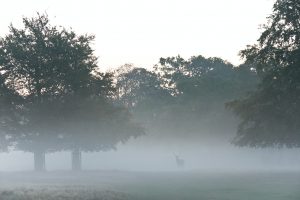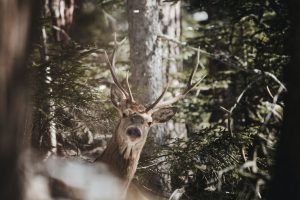 With more and more hunters joining the sport everyday, deer are more pressured than ever.
With more and more hunters joining the sport everyday, deer are more pressured than ever.
This additional hunting pressure pushes deer that normally spend more time in the open to thicker cover.
If you want to be successful nowadays, especially on public land, you need to go deeper and farther.
10 Tips for Hunting Deer in Thick Woods and Brush
Tip 1. Scouting
Scouting ahead of hunting season will help you identify these areas of thick woods and brush that deer will head once pressured.
One thing to keep an eye out for are paths that deer travel through these thick woods. To find these, you must head into the thick brush. You should come across what look like historically used trails.
Try to identify feeding areas and bedding areas, then set yourself slightly off the path between the two. You will want to sit on the ground just outside of these travel corridors.
Look for good shooting lanes ahead of time. Nothing worse is encountering a big buck in thick woods only to not be able to get a shot off at him.

Tip 2. Safety First
If you are hunting a public area, wearing some blaze orange in thick brush is a must. With more and more inexperienced hunters in the field, you do not want to run the risk of a hunter thinking you are a deer.
Only hunt during legal hunting hours. Many hunters wonder, can I hunt deer at night? The answer is no. It is illegal and dangerous to do so.
Tip 3. Have the Right Equipment
There are two important pieces of equipment you want to consider when hunting in thick brush:
- Good low magnification scope: Since you are going to be setup to take a shot 20-40 yards away, you want to make sure your scope is low enough magnification that you won’t have any trouble getting the deer in your sights when the time comes. 1-3x will be your best bet.
- Make sure you are comfortable: Since you are going to be sitting still for long periods of time, consider bringing a good hunting cushion to sit on.
Tip 4. Clear Shooting Lanes
You can use an axe to clear some space and a shooting lane ahead of time. A good tip is to cut multiple shooting lanes in case you miss your first opportunity
This may sound like a lot of work, and it is. But this is what it takes to be successful when hunting thick woods.
Tip 5. Consider Backdrop
Make sure you are well covered and concealed. While deer are not colorblind, they are able to see blue much better than green and red.
Consider your backdrop and what you will look like to any approaching deer. Using the backdrop properly is more important than the exact camo pattern you wear.
Look for a good location on the ground. You are going to want to avoid using a tree stand in these thick woods as the deer will recognize them as being out of place.

Tip 6. Use a Distraction
Set something simple and foreign to the deer right near the path you expect them to take. Make sure it coincides with when you want to take your shot. This can help provide an opportunity you as the hunter to get a good shot when the deer stops to evaluate the situation. This is an old trick used by deep woods hunters.
Tip 7. Stay still, Be quiet, and Listen
- Stay Still: Try to limit your movement and fidgeting once you settle in your stop. Any quick movements seen by the deer are likely to spook them.
- Be Quiet: Deer have much better hearing than we do. They are also accustomed to what sounds normal in the woods and what doesn’t thanks to generations of evolution. The quieter you can be the better.
- Listen: Listen closely as you will often hear an approaching animal long before you can see it. This will give you time to prepare and get into a good shooting position.
Tip 8. Pay attention to the wind
Being upwind of deer is one of the quickest ways to alert them of your presence. Deer are able to smell humans from up to 1/2 mile away. Not taking wind direction into account is one of the most common mistakes inexperienced hunters make. Having a good wind checker handy can help determine wind direction quickly and easily.
Tip 9. Travel Quietly
If you can, use paths softened from rain or snowfall for your entry and exit routes. This will help you stay quiet and make you less likely to spook animals in the area. Deer are often sensitive to the movement of other animals and use them as warning signs that they may be in danger.
Move slowly and time your footsteps randomly when walking. Take short pauses and breaks between steps to mimic the movement and sounds other animals in the woods make.
Tip 10. Don’t get discouraged
Often as soon as you drop your guard is right when a deer will pop up. You don’t want to miss your chance when it finally presents itself because deer are incredibly fast. You might only have a brief moment to get a good shot off so you need to remain focused and prepared for when your opportunity arises.